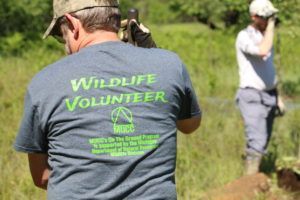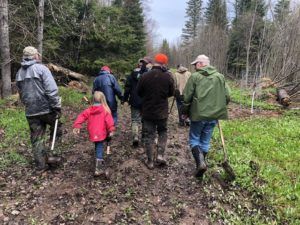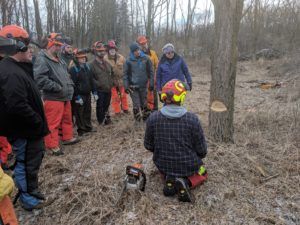OTG: Behind the Scenes
 Have you ever wondered what goes into creating an OTG project?
Have you ever wondered what goes into creating an OTG project?
MUCC and the Wildlife Division of Michigan’s Department of Natural Resources (MDNR), recognize that many people value the game areas and state forests, whether you are hunting, fishing, hiking, birding, or kayaking. We want to give you that avenue to further connect with your lands and further enhance them for future generations. By just being an OTG volunteer, you are already pushing past boundaries that many people miss or simply did not know exists. You are dedicating time out of your lives to give back to our public lands; making time to better the environment and all the plants and animals in-between. The purpose of this blog is to tell you why and how we do what we do for OTG and how we couldn’t do it without you and the MDNR.
Makhayla LaButte (MUCC Habitat Volunteer Coordinator) and all those who came before her, have worked to make connections with each Wildlife Biologist across the state, making it possible for you to get involved. State game areas and state forests, all the way from the western upper peninsula to the southeast corner of the lower peninsula have management plans set into place to maintain and enhance a specific game area or state forest. After communicating with the biologist we come up with a project that is best suited for our volunteers and that also aligns with the management plan.
Now comes the time to recruit for the project and find people like you. It is not always the easiest thing, being that everyone can communicate differently. Our main sources of communication are through emails (so check your email), Facebook, flyers, word-of-mouth and blog postings on our website. Our target audiences are typically outdoor focused organizations, clubs, businesses, groups, etc. We are always looking for new connections, especially college kids. Personally being fresh out of college, listen to me when I tell you, that OTG can benefit you in many ways (you are welcome to email me at americorps@mucc.org
to find out how). On average we send out 60 emails, and me saying this isn’t to complain, but to get you to realize how serious and involved we are in recruiting for projects. We know you care, we know you want to help, we try our best to find people like you.
thing, being that everyone can communicate differently. Our main sources of communication are through emails (so check your email), Facebook, flyers, word-of-mouth and blog postings on our website. Our target audiences are typically outdoor focused organizations, clubs, businesses, groups, etc. We are always looking for new connections, especially college kids. Personally being fresh out of college, listen to me when I tell you, that OTG can benefit you in many ways (you are welcome to email me at americorps@mucc.org
to find out how). On average we send out 60 emails, and me saying this isn’t to complain, but to get you to realize how serious and involved we are in recruiting for projects. We know you care, we know you want to help, we try our best to find people like you.
To prepare for the actual project we are constantly communicating with the wildlife biologists and technicians, to finalize details. We discuss what tools to use, what time to meet, location, project size, methods and more. If necessary, we head out to the project site and spend several hours pepping it for the project. Once all of that is set into place we jump back onto the computer and work on articulating the details to you, the volunteer. The smaller details include finding lunch to provide and watching for the weather.
 When the day of the project arrives, that’s when everything comes together and the reason why we do what we do truly shines through. Such projects include tree plantings, invasive species removal, habitat building, river clean-ups, trail clearing, brush clearing, and much more. Every project has an impact on wildlife and its habitat. You come to volunteer because you want to, you care and you want to make a difference, all we have to do is give you a stage in order to do so. Thank you for being an OTG volunteer, see you soon at an event.
When the day of the project arrives, that’s when everything comes together and the reason why we do what we do truly shines through. Such projects include tree plantings, invasive species removal, habitat building, river clean-ups, trail clearing, brush clearing, and much more. Every project has an impact on wildlife and its habitat. You come to volunteer because you want to, you care and you want to make a difference, all we have to do is give you a stage in order to do so. Thank you for being an OTG volunteer, see you soon at an event.
The post OTG: Behind the Scenes appeared first on Michigan United Conservation Clubs.



